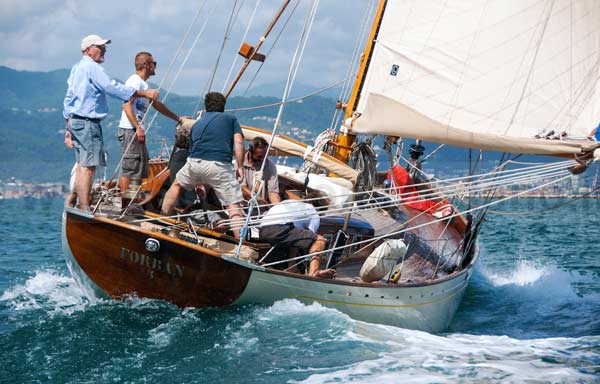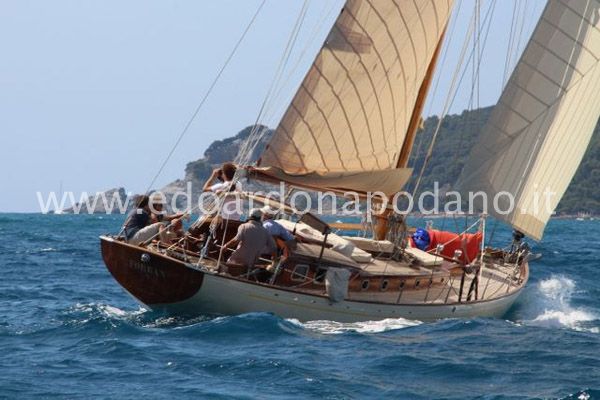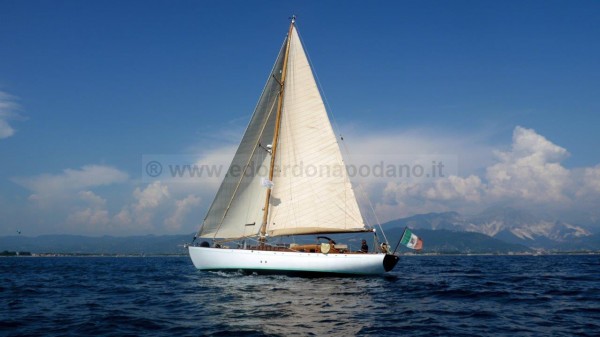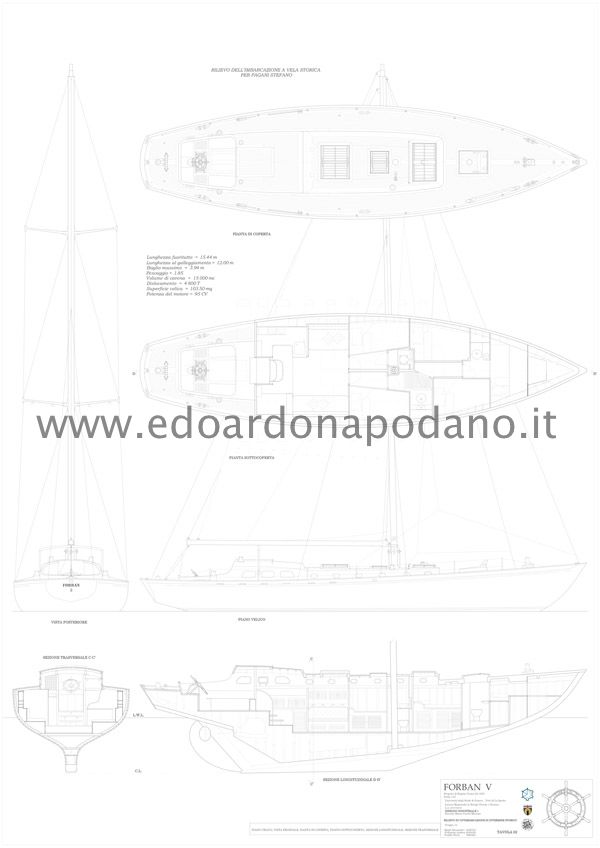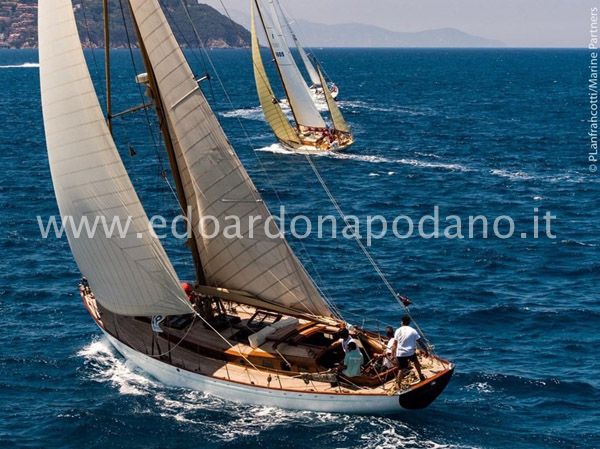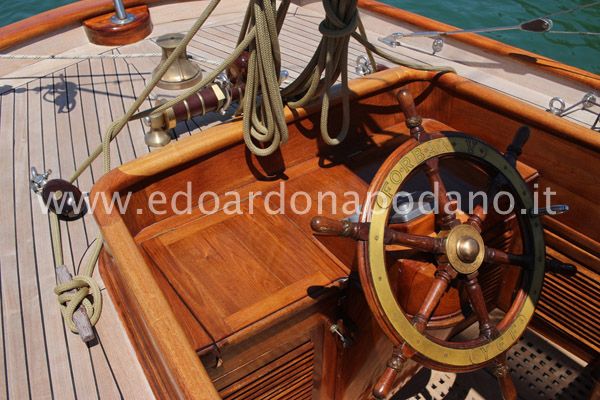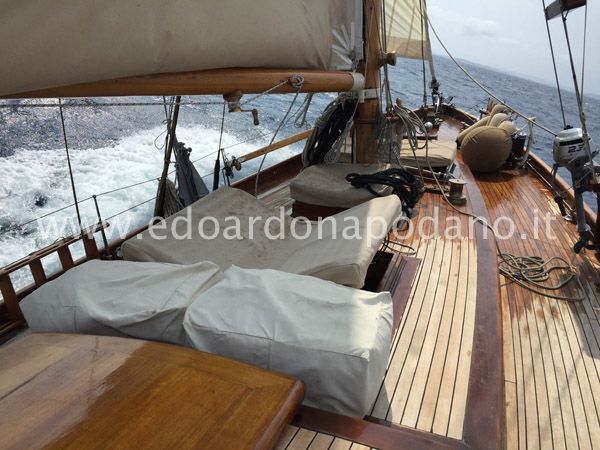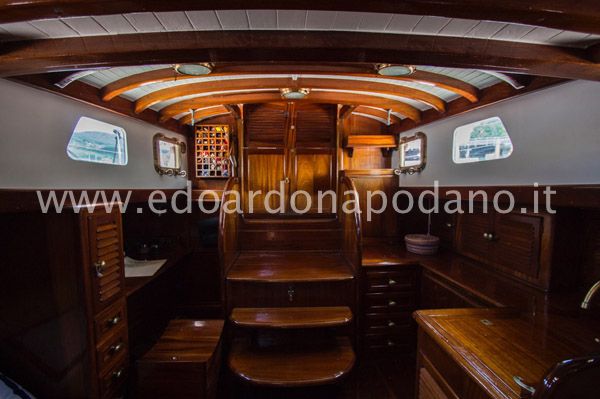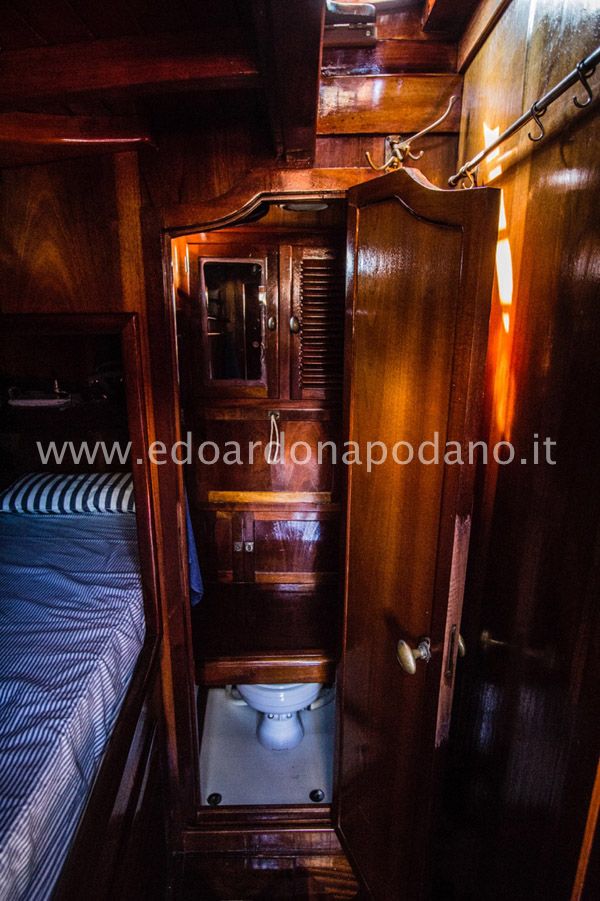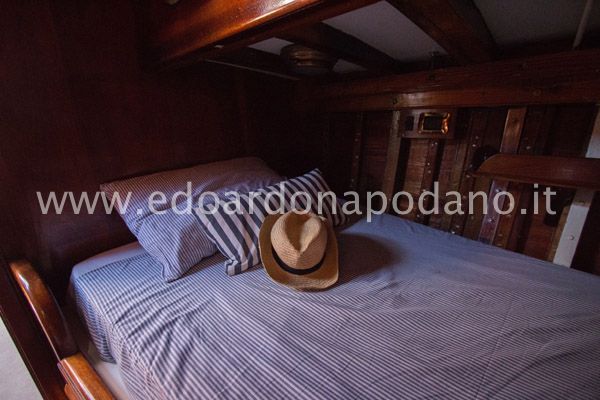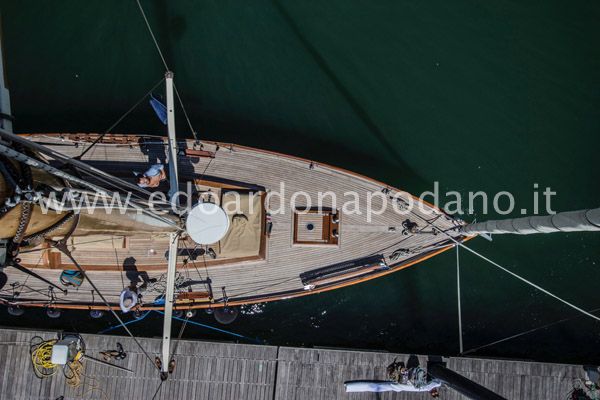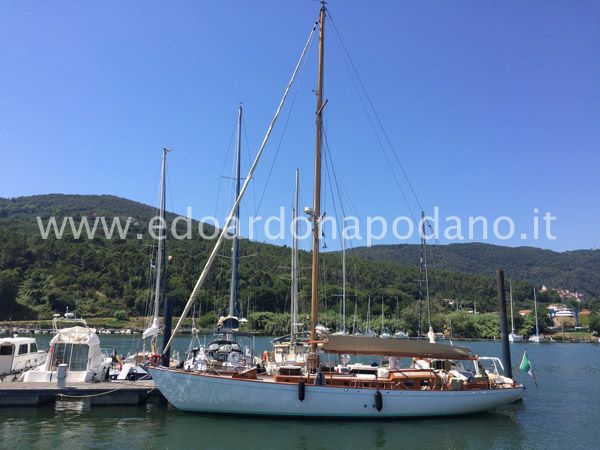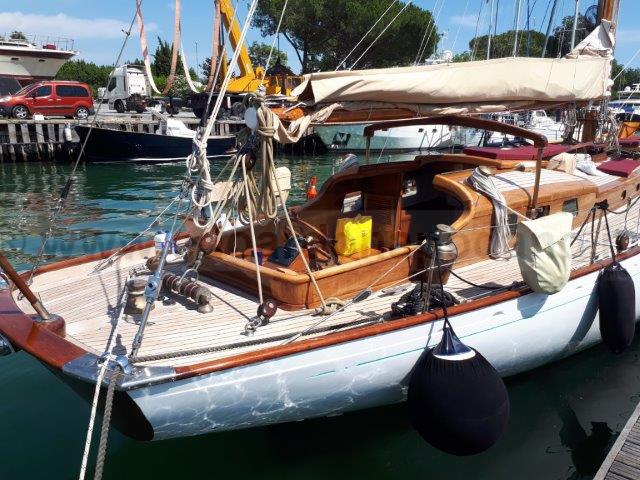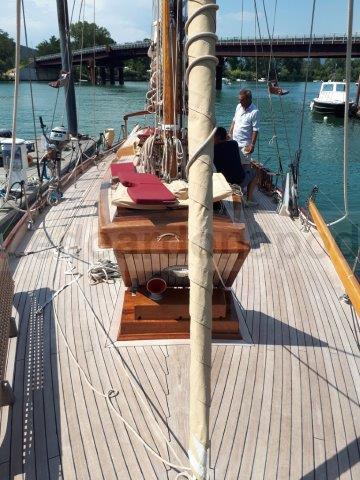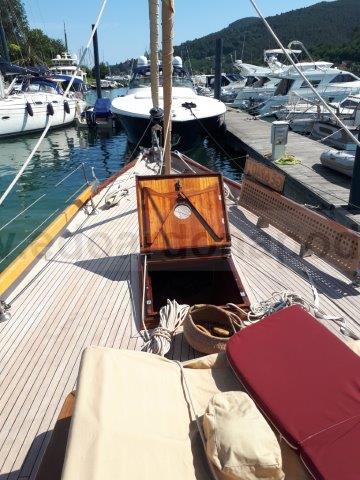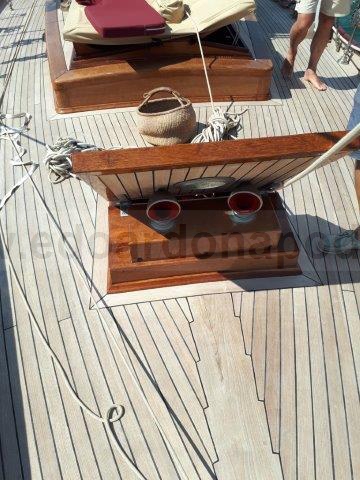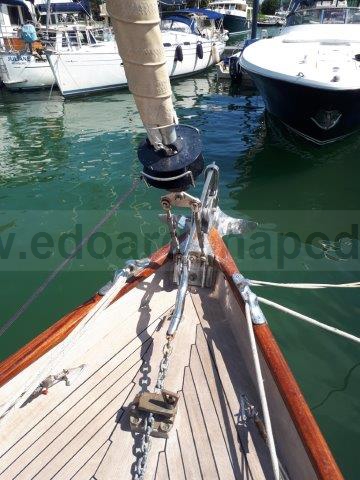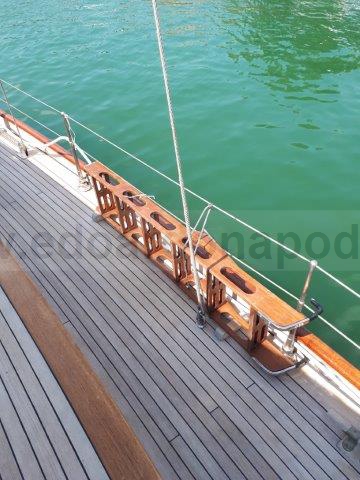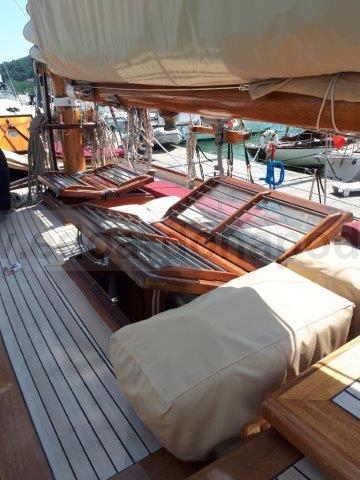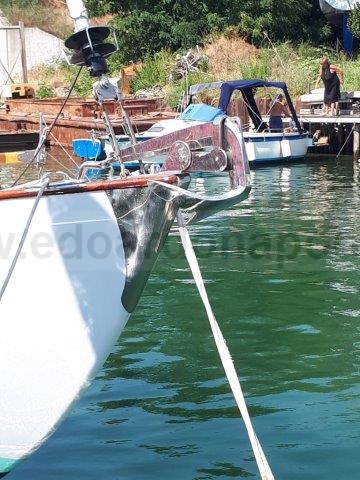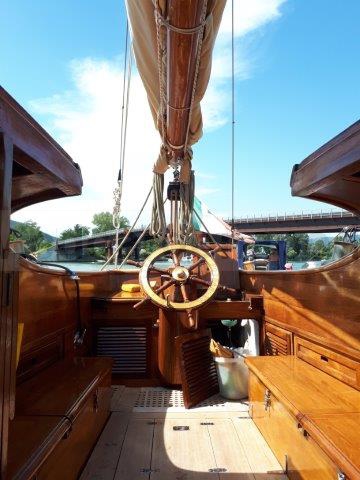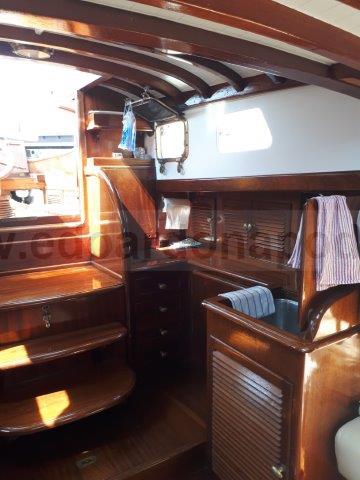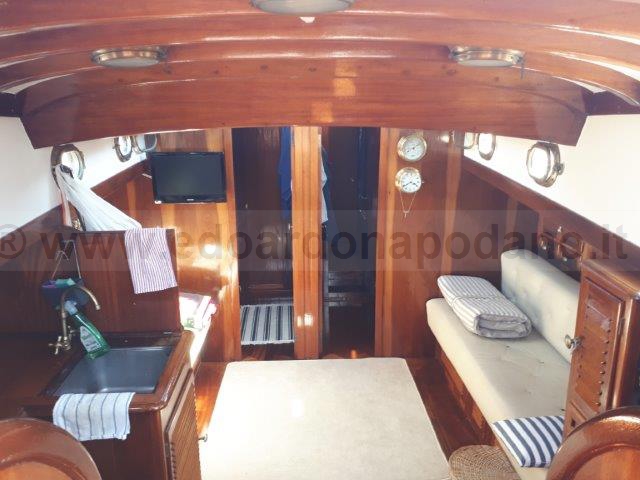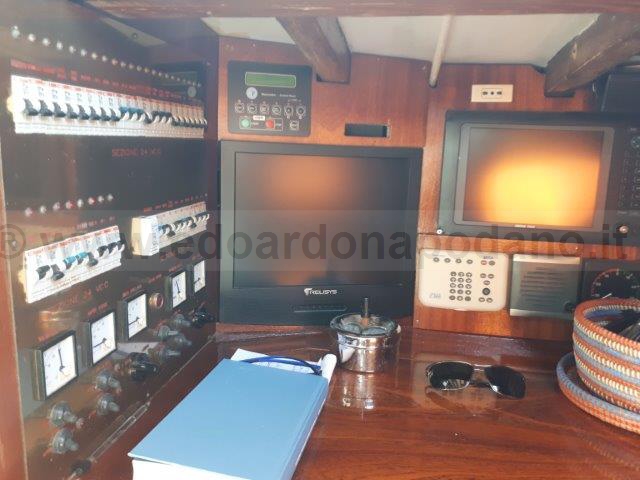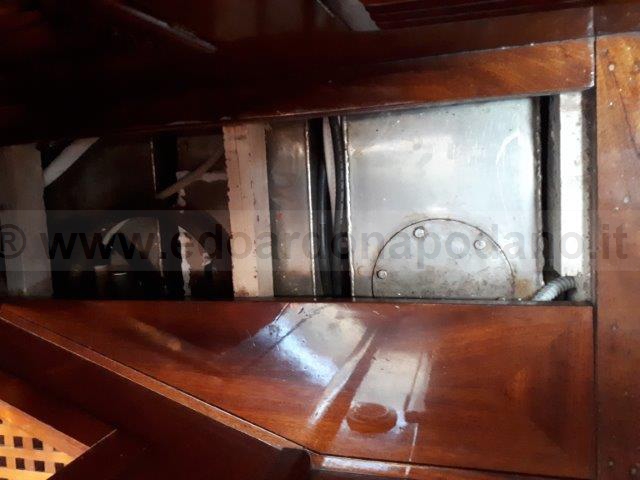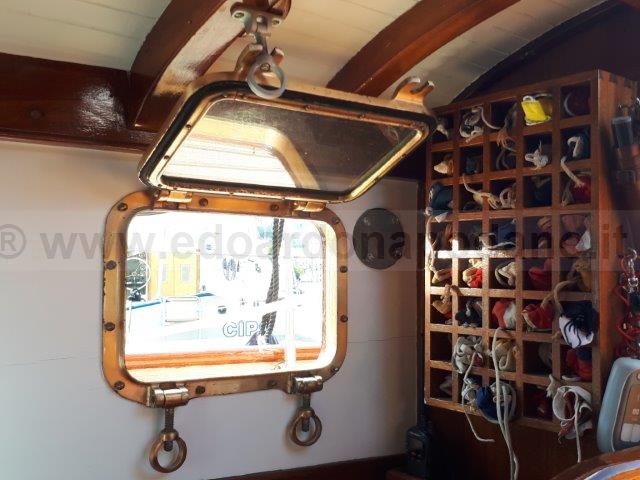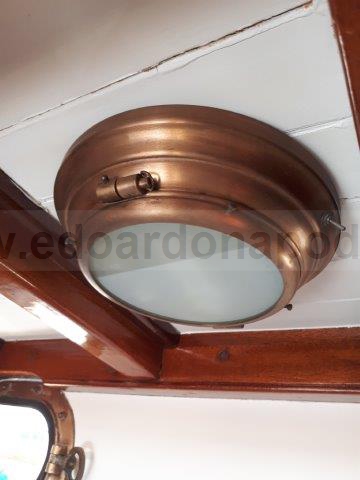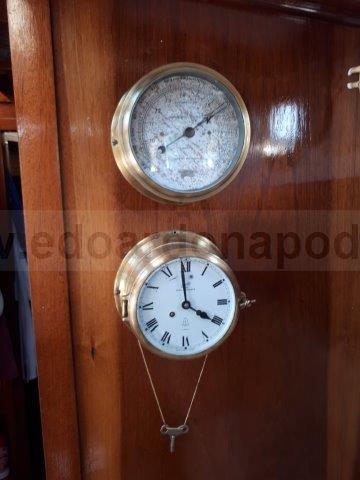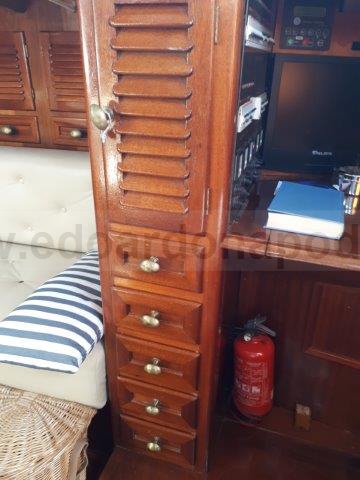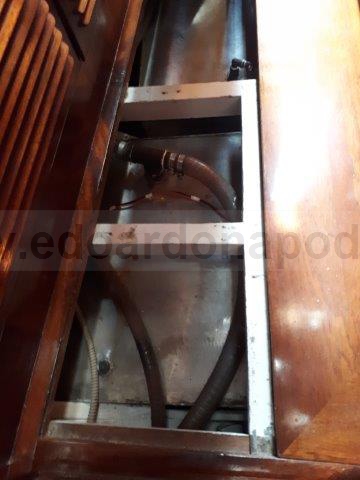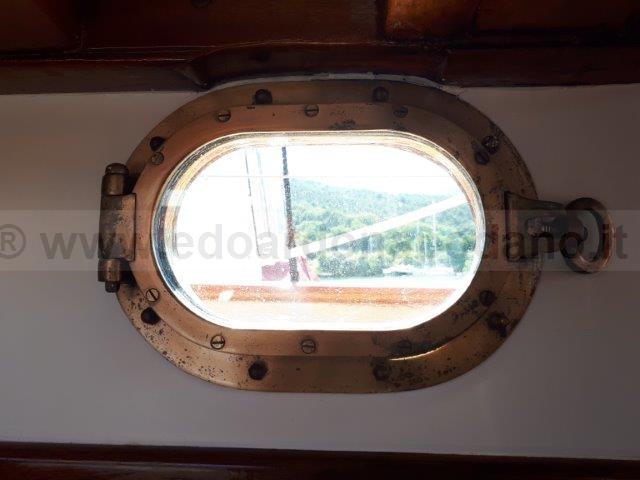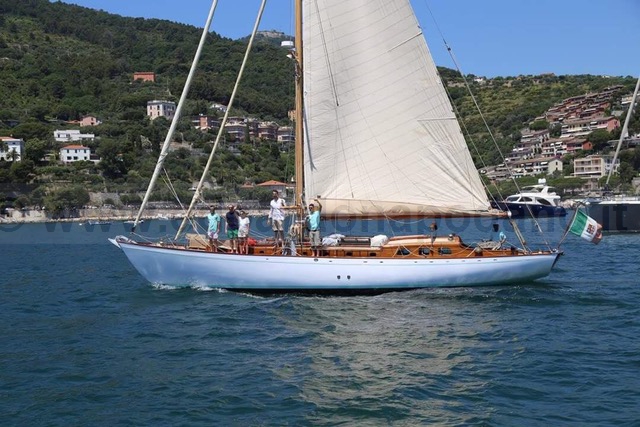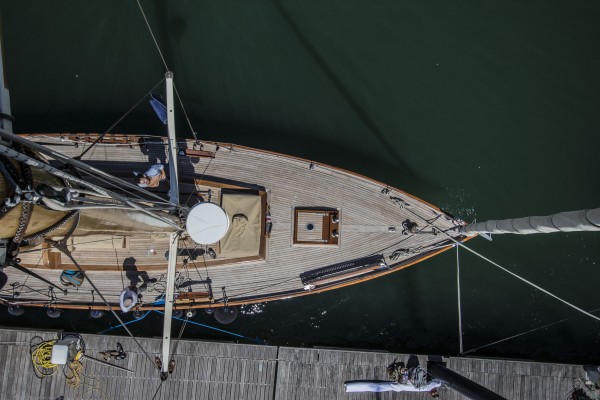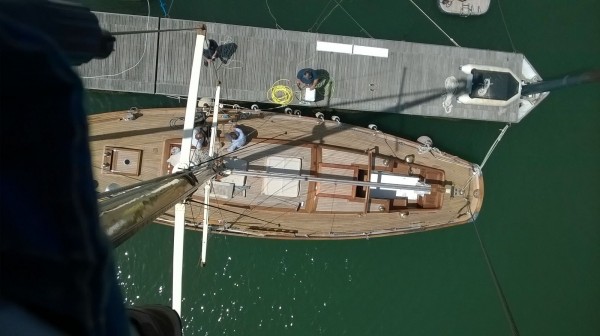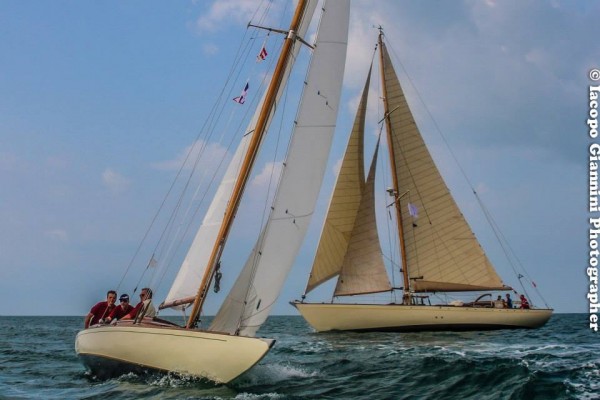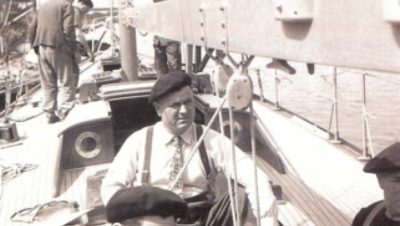Some further pictures at the bottom, included 2 marvellous old “Le Yacht – journal de la marine” covers. more history and specification
Many new pics available and some already published at the bottom of this article.
For a full video please have a look to this link or copy the URL:
A BIT OF HISTORY
The Forban 5 was built in 1954/55, on a project by the famous naval architect Eugène Cornù, from the Paul Jouet shipyard in Sartroville, on the Seine.
The materials used in the construction are oak and elm for the keel, mahogany for the planking, elm for the frames and teak for the deck and superstructures.
The rigging is a cutter with a spruce mast and boom, yankee or jib rollable and self-tacking boomed staysail; lately it is also possible to arm a gennaker.
The Forban project was commissioned to Cornu by a certain Mr. Jordan in 1953. In September of that year, the first construction plans date back, recovered from the Musée de la Marine in Paris.
the original design data shown in the plans are as follows:
• length f.t. mt. 15,30
• waterline length mt. 12,00
• width mt. 3.90
• draft mt. 1.85
In the following year, new plans were developed for the future true owner, this Mr. J.D. Dollfus who, after the launch, moved the boat in the Mediterranean to Antibes.
The “Le Yacht” newspaper of June 1955 reports the photo of the boat moored in the port of the French Riviera town (see photos of the boat just launched in March 1955 and then in Antibes, taken from the covers of Le Yacht)
From the REGISTER OF YACHTS of 1963 the Forban V is registered at No. 2834 at Sète parking port, while in 1979 it is registered at No. Y035828, still in the name of Mr. Dolfuss, in Hyeres.
There is no other news from that period.
Subsequently, he seems to have sailed first to the Balearic Islands and then to the island of Elba where, for a time, he carried out charter activities.
In rather precarious conditions, in 1998 it was purchased by a group of enthusiasts who, between 1999 and 2000, provided for a complete refitting. A large part of the planking of the quick work (until then covered in copper), the remaking of the deck and the formation of a new interior layout (described below) are replaced.
The original plan, in fact, provided for the central descent, with a much smaller ladder than the current one, the port side kitchen, more contained than the existing one, on the starboard the chart table, a dinette with a large starboard table and two sofas opposite, if necessary usable as bunks, more forward, before the mast were the head, compartmented and separated by doors, including sink, shower, toilet and waxed wardrobe.
Next to the mast there are two cabins with independent access, one larger than the other, equipped with very large berths.
Still in the bow was the sailor cabin, separated from the guest cabins, by a storage room that occupied the entire width of the hull.
In the crew cabin, directly accessible from the deck via a walled ladder, two bunks and a toilet.
As mentioned, currently, the interior layout is substantially modified and guarantees exceptional habitability for a classic boat.
The new owner, who has always been passionate about classic boats, buys it in 2013 and during the winter provides for a new extraordinary maintenance intervention with partial remaking of the planking at the waterline, the painting of the hull and the substantial overhaul of all on-board systems and equipment. The following year it was the turn of the tree and part of the armor to replace the steering wheels and backstay. The deckhouse risers are also completely renovated and the refitting of the deck woods is completed.
Returning to the sea in the summer of 2014, she participated in the 10th and 11th VSV gathering, at the Valdettaro Classic Boat, several times at the Mariperman, at the Panerai Argentario Sailing Week trophy; occasions in which it has made itself known and admired in its particularly powerful lines.
TIPO/TYPE: Cutter sloop
CANTIERE/SHIPYARD: Paul Jouet – Sartroville, France
DESIGNER: Eugène Cornù
ANNO/YEAR 1955
LUNG.f.t./LOA: mt 15,30
B. MAX: mt 3,90
PESCAGGIO/DRAFT: mt 1,85
MAT.SCAFO/HULL MATERIAL: Legno / Wood
Chiglia: rovere e olmo – fasciame: mogano
Ordinate: olmo – coperta: teak
INTERNI / ACCOMODATION
CABINE/CABINS: 2 + 1
POSTI LETTO/BERTHS: 4 + 2
BAGNI/TOILET: 2 + 1
COL. SCAFO/HULL COLOR: Bianco/ White
MOTORE / MACHINERY
MARCA /BRAND: Perkins 100 hp – elica tripala in bronzo
SERBATOIO CARBURANTE: lt 550 (inox)
SERBATORIO ACQUA: lt 450 (inox)
PRESTAZIONI MOTORE: crociera 6,5 kn – max 8 kn
PRESTAZIONE A VELA: max 9,5 kn
VELE E ATTREZZATURA DI COPERTA
(tutte del 2015/2016): randa, fiocco rollabile, trinchetta rollabile, gennaker
4 winch manuali a doppia velocità, winch elettrico di tonneggio e randa a poppa, winch elettrico alla base albero, salpa ancora/tonneggio di prua elettrico, sartie volanti non strutturali con sgancio rapido, paterazzo con arridatoio a manovella, strallo trinchetta sgancio rapido, sartie in trefolo nuove.
Tutti gli arridatoi in bronzo sono originali.
Ancora ammiragliato di rispetto, campana nebbia e tromba.
STRUMENTI / INSTRUMENTS
Radar , plotter GPS, windex, autopilota, VHF, antenna tv
ACCESSORI
Generatore Onan 6 kw, dissalatore 90 lt/h, inverter 24V/220V, riscaldamento Webasto (serbatoio separato), boiler 60 lt (elettrico e motore), serbatoio acque grigie.
Tender nuovo con motore 2,5 cv. 4 tempi, cagnaro invernale completo nuovo, tendalini estivi, cuscinerie, due zattere autogonfiabili da 6 persone in coperta.
Sul progettista: http://www.bateau-vintage.com/blog/histoire/eugene-cornu-architecte-naval.html
UN PO’ DI STORIA
Il Forban 5 è stato costruito nel 1954/55, su progetto del famoso architetto navale Eugène Cornù, dal cantiere di Paul Jouet a Sartroville, sulla Senna.
I materiali impiegati nella costruzione sono il rovere e l’olmo per la chiglia, il mogano per il fasciame, l’olmo per le ordinate ed il teak per la coperta e le sovrastutture.
L’armo é a cutter con albero e boma in spruce, yankee/fiocco rollabile e trinchetta bomata auto virante; ultimamente è possibile anche armare un gennaker.
Il progetto del Forban venne commissionato a Cornu da un certo sig.Jordan nel 1953. Al settembre di quell’anno risalgono i primi piani di costruzione, recuperati dal Musée de la Marine di Parigi.
i dati di progetto originali riportati nei piani sono i seguenti:
• lunghezza f.t. mt. 15,30
• lunghezza al galleggiamento mt. 12,00
• larghezza mt. 3,90
• pescaggio mt. 1,85
Nell’anno successivo vennero sviluppati nuovi piani per il futuro vero armatore, tale sig. J.D. Dollfus che, dopo il varo, trasferì la barca nel Mediterraneo ad Antibes.
Il giornale “le Yacht” del giugno del 1955, riporta la foto della barca all’ormeggio nel porto della cittadina della Costa Azzurra (vedi fotografie della barca appena varata nel marzo 1955 e poi ad Antibes, riprese dalle copertine di Le Yacht)
Dal REGISTER OF YACHTS del 1963 il Forban V risulta registrato al n°2834 con porto di stazionamento Sète, mentre nel 1979 risulta registrata al n° Y035828, sempre a nome del sig. Dolfuss, a Hyeres.
Di quel periodo non si hanno altre notizie.
Successivamente pare abbia navigato prima alle Baleari e poi all’isola d’Elba dove, per un certo tempo, ha esercitato attività di charter.
In condizioni abbastanza precarie, nel 1998 viene acquistato da un gruppo di appassionati che provvedono, tra il 1999 ed il 2000, ad un refitting completo. Si provvede alla sostituzione di buona parte del fasciame dell’opera viva (fino a quel momento rivestita in rame), al rifacimento della coperta ed alla formazione di una nuova disposizione degli interni (descritta avanti).
Il piano originale, infatti, prevedeva la discesa centrale, con una scala molto più piccola dell’attuale, la cucina a babordo, più contenuta di quella esistente, a dritta il tavolo per il carteggio, una dinette con tavolo ampio a dritta e due divani contrapposti, all’occorrenza utilizzabili come cuccette, più a prua, prima dell’albero erano i servizi, compartimentati e separati da porte, comprendenti lavabo, doccia, w.c. e armadio cerate.
Avanti l’albero due cabine con accesso indipendente, una maggiore dell’altra, dotate di cuccette molto ampie.
Ancora a prua, era la cabina marinaio, separata dalle cabine ospiti, da un vano ripostiglio che occupava l’intera larghezza dello scafo.
Nella cabina marinaio, direttamente accessibile dalla coperta mediante una scaletta a murata, due cuccette ed un w.c.
Come detto, attualmente, la disposizione degli interni è sostanzialmente modificata e garantisce un abitabilità eccezionale per una barca classica.
Il nuovo armatore appassionato da sempre di barche classiche, l’acquista nel 2013 e durante l’inverno provvede ad un nuovo intervento di manutenzione straordinaria con rifacimento parziale del fasciame in corrispondenza della linea di galleggiamento, alla pitturazione dello scafo e alla sostanziale revisione di tutti gli impianti e dotazioni di bordo. L’anno successivo tocca all’albero e a parte dell’armo con sostituzione delle volanti e del paterazzo. Sono inoltre completamente ristrutturate le alzate della tuga e completato il refitting dei legni in coperta.
Tornata in mare l’estate del 2014, ha partecipato al X ed XI raduno VSV, al Valdettaro Classic Boat, varie volte al Mariperman, al trofeo Panerai Argentario Sailing Week; occasioni in cui si è fatta conoscere ed ammirare nelle sue linee particolarmente potenti.
DOTAZIONI DI BORDO
Armo: cutter sloop con trinchetta bomata autovirante
Vele (tutte del 2015/2016 e oltre): randa, fiocco rollabile, trinchetta rollabile, gennaker
Attrezzatura di coperta e rigging: 4 winch manuali a doppia velocità, winch elettrico di tonneggio e randa a poppa, winch elettrico alla base albero, salpa ancora/tonneggio di prua elettrico, sartie volanti non strutturali con sgancio rapido, paterazzo con arridatoio a manovella, strallo trinchetta sgancio rapido, sartie in trefolo nuove.
Tutti gli arridatoi in bronzo sono originali.
Ancora ammiragliato di rispetto, campana nebbia e tromba.
Motore: perkins 100 cv. in perfetto stato, elica tripala in bronzo con elica di rispetto, quadro elettrico strumenti nuovo.
Elettronica navigazione: radar, plotter di navigazione con gps, stazione del vento integrata con secondo computer di bordo esterno, 3 bussole, pilota automatico, radio VHF + portatile, antenna tv.
Attrezzature di bordo: attacco per corrente in banchina, generatore Onan 6 kw, dissalatore 90 lt./h, inverter 24v/220v, riscaldamento webasto con serbatoio separato, boiler 60 lt doppia funzione (elettrico e motore), autoclave (nuova) e pompa manuale, circuito separato acqua di mare,
serbatoi acqua dolce inox 450 lt., serbatoio gasolio inox 550 lt, serbatoio acque grigie.
Confort di bordo: ampia e luminosa dinette con due tavoli estraibili dal pavimento, due divani in pelle, carteggio, cucina a scomparsa con freezer e frigorifero molto ampi.
Dalla dinette si accede, a sinistra, ad una cabina dotata di piccolo servizio igienico en suite; a destra, alla cabina passante, che attraverso il bagno principale, da accesso alla cabina master, dotata di due cuccette. Tutte le cuccette misurano 1,20 x 2,00 mt.
Più a prua la cabina marinaio con servizio indipendente ed accesso anche dalla coperta, tramite il tambuccio di prua.
Complessivamente, oltre all’equipaggio (2 persone), possono trovare posto 4 ospiti in maniera estremamente comoda.
Le cabine offrono ampi spazi di stivaggio sotto le cuccette.
Pozzetto ben riparato dotato di 4 cassetti e 6 gavoni; tavolo esterno estraibile dal pavimento.
Accessori: tender nuovo con motore 2,5 cv. 4 tempi, cagnaro invernale completo nuovo, tendalini estivi, cuscinerie, due zattere autogonfiabili da 6 persone in coperta.
English
ACCESSORIES
Onan 6 kw generator, watermaker 90 lt / h, 24V / 220V inverter, Webasto heating (separate tank), 60 lt boiler (electric and motor), gray water tank.
New dinghy with 2.5 hp engine. 4-stroke
Complete new winter awning, summer awnings, cushions, two self-inflating rafts for 6 people on deck.
SAILS AND DECK EQUIPMENT
(all of 2015/2016): mainsail, furling jib, furling staysail, gennaker
4 manual double speed winches, electric winch with awning and mainsail at the stern
electric winch at the mast base, electric windlass / bow anchor
non-structural running backstay with quick release
backstay with turnbuckle
quick release forestay
new strand shrouds
All the bronze turnbuckles are original.
Spare yachtsman anchor, fog bell and trumpet.
INSTRUMENTS
Radar, GPS plotter, windex, autohelm, VHF, tv antenna
HULL MATERIAL: Wood
Oak and elm for the keel
Mahogany for the planking
Elm for the frames
ACCOMODATION
CABINS: 4 + 1
BERTHS: 4 + 2
TOILET: 2 + 1
HULL COLOR: White
MACHINERY
ENGINE: Perkins 100 hp – Triple blade bronze propeller
FUEL TANK: lt 550 (inox) – 120 uk gal
WATER TANK: lt 450 (inox) – 99 ik gal
NEW PICS 2019

